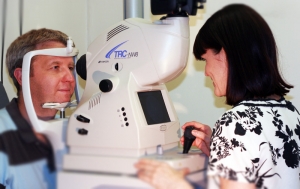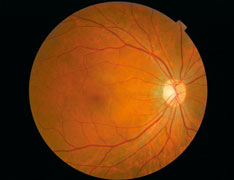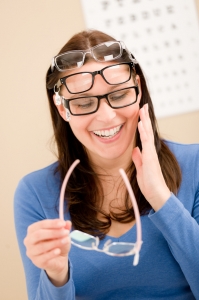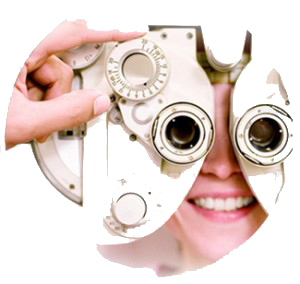Your sight test explained
At Ridings Opticians, we are dedicated to offering you the best possible service when it comes to caring for your eyes. From advice about keeping your eyes healthy to helping you choose the right glasses or contacts, our fully qualified opticians are here for you every step of the way.
To find out more information, you can request a lens fitting or sight test online. Alternatively, feel free to contact us if you have any questions or require more information.
Most of us incorporate heavy computer use, driving in all conditions and watching television into our everyday lives. Whilst these situations are unavoidable for many, unfortunately, this does mean that our eyes are put under more strain than ever before.
Healthy, well looked after eyes can make a massive difference to your all round well-being and the best way to maintain this is through regular eye examinations.
Having clear, comfortable vision is paramount and we always use the very latest in eye examination technology to ensure that we can provide an accurate assessment of your ability to see. Regular sight tests also gauge the general health of your eyes and can result in the early identification of other eye problems such as diabetes and high blood pressure.
Our examinations take around 40 minutes and can be booked over the phone, online or by visiting our store.
You can be rest assured that although having an eye test is a very simple and straightforward process, all our examinations are very thorough. Lasting approximately half an hour, one of our opticians will look closely at all aspects of your vision and eye health.
A few questions will be asked about your sight, general health, your family’s health and your lifestyle. There are lots of different tests that can be carried out during your eye examination so your optician will tailor this to suit your individual needs. While testing your eyes, the optician will look at the following:
- Vision quality
- Unaided and aided vision (with any glasses or contact lenses you already use)
- Eye muscle performance and health
- Internal eye health – ideally using our state of the art Retinal Scanner
- Front of eye health, including eye fluid pressure
- Further tests for depth perception, colour vision and visual field may also be performed if required
All of our tests are carried out using the very best in eye examination technology and your optician will provide step-by-step explanations so you know exactly what is involved at each stage.
The following guide provides a brief overview of what is involved in each of the different tests your optician may carry out:
Non-Contact Tonometer:
The tonometer measures the pressure inside your eyes, known as intraocular pressure. A puff of air is directed into the eye. The air bounces back at the instrument, giving a measurement of the pressure inside each eye. It only takes a couple of seconds to perform and is an important test, as high pressure can indicate the early stages of glaucoma, a sight-threatening condition. Caught early, these can easily be corrected and treated.
Retinoscope:
By observing how the eye processes a beam of light, your optician can determine if you suffer from myopia (nearsightedness), hypermetropia (farsightedness) or if you have astigmatism. The test only takes a few seconds and is extremely accurate.
The Test Chart:
The test chart is probably the most familiar piece of equipment. The most common chart is the Snellen chart, which is a series of letters of differing sizes – ranging from the largest at the top to the smallest at the bottom. The results for one eye often vary from the other, so each eye will be tested individually before both eyes are finally tested together. The optometrist flips different lenses in front of your eyes that change how clearly you can see. Depending on your answers, they change the lenses until you have the clearest, most comfortable vision possible.
The Opthalmoscope:
This is used to examine the retina at the back of the eye, including the blood vessels and the front of the optic nerve. It can also detect any changes in the health of this area that may indicate underlying diseases such as diabetes, high blood pressure or macular degeneration. The optician darkens the room and shines a bright light into each eye in turn using the ophthalmoscope.
Fixation Disparity Test:
This determines if your eyes are working well together and how much correction may be needed to balance your eyesight. You will be asked to look at a panel and say whether the bars appear to be in line both horizontally and vertically.
The Slit Lamp:
The slit lamp is a powerful, illuminated microscope that is used to examine the outer surface of your eyes – the cornea, the iris and the lens – to check for abnormalities or scratches. The slit lamp examination is particularly important for contact lens wearers.
Visual Field Screener:
This is used to determine your field of vision and to locate any ‘blind spots’ within that field. A visual field screener randomly flashes dots of light on a black background. If you fail to see any of the dots, this can be an indication of a blind spot.
Testing your Focus:
Most people who have trouble focusing on either near or distant objects can have their eyesight easily corrected by prescription lenses. To find out if you need corrective lenses, your optician will test your ability to focus on both close-up and distant objects.
What is Retinal Screening?

We aim to provide you with the highest standard of eyecare so with the latest technology we can take photographs of the back of your eye (the retina).
The digital retinal camera helps us to detect eye conditions such as Glaucoma, Age Related Macular Degeneration and Diabetic Eye Disease. We can monitor conditions by taking and storing photographs on successive visits.

It only takes seconds to take a photograph and it can be carried out during your routine eye examination or at a separate visit.
As this service is not covered by the standard sight test fee a modest charge of £10 is applicable. When you see the resulting photographs I am sure you will see their value.
If you wish to have photographs taken please advise reception and they will make the necessary arrangements.
Following your eye examination, the optician will pass the results and their recommendations to one of our expert dispensers. Our dispensers are on hand to help you select a pair of glasses that suit your face perfectly, or alternatively, the right contact lenses for your requirements.
At Ridings Opticians we know that our customers are looking for quality and style. It’s for this very reason that we work hard to make sure that our collection offers the most exciting new styles and the best possible choices for you.
Take a look at the designer mens and womens spectacle brands available at Ridings Opticians. From classic, understated frames to bolder styles, all are designed to help you look and see your best.
 When you return to the store to collect your glasses, the dispensing assistant will have them ready for you. They will check that the glasses fit well, sit comfortably, that you can see clearly through them and will also make any necessary minor adjustments to ensure that they’re just right.
When you return to the store to collect your glasses, the dispensing assistant will have them ready for you. They will check that the glasses fit well, sit comfortably, that you can see clearly through them and will also make any necessary minor adjustments to ensure that they’re just right.
If you are new to wearing glasses, it may seem a little strange at first but the dispensing assistant will give you helpful tips on how to wear and also care for your new glasses.
To keep your prescription up-to-date and to help take care of all your eye care needs, we will be in touch to let you know when you are due your next eye examination.
Discover the range of mens and womens eyewear brands available at Ridings Opticians

